Research Topic
In today’s global economy, can organized labor unions survive?

Introduction
Labor unions have been around for long. The main reason why labor unions cannot be wished away is the role collective bargaining plays in industrial relations.
The world has been changing and we now live in a globalizing economy. It would be interesting to appreciate how trade unions have transformed to meet the needs of the workers in our world of today.
The proposed research work seeks to establish whether the trade unions will survive in the global economy or not. This presentation set out how the research work is to be done.
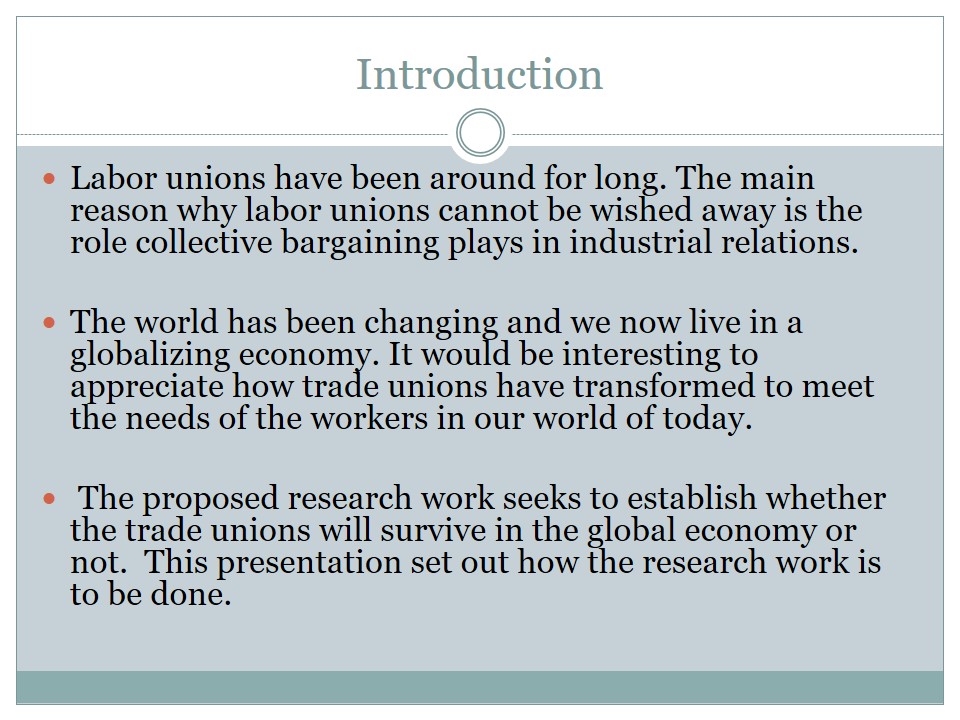
Definition of Main Concepts
Labor Unions
There are three parties to labor relations i.e. employees and employers (Marot, 2009). Overtime, employees realized that they can best advocate for their interests as a body or when united as a group of employees. It was realized that if employees united and spoke with one voice, employers were more likely to listen than when they agitated for their interests as individual.
A labor union therefore is a body of employees united to collectively pursue better employment terms, working conditions and general welfare
Therefore, a labor union is an organ that engages in collective bargaining on behalf of its members. This unions have been there since the industrial revolution era in Europe and their purpose is to negotiate better terms of engagement with employers
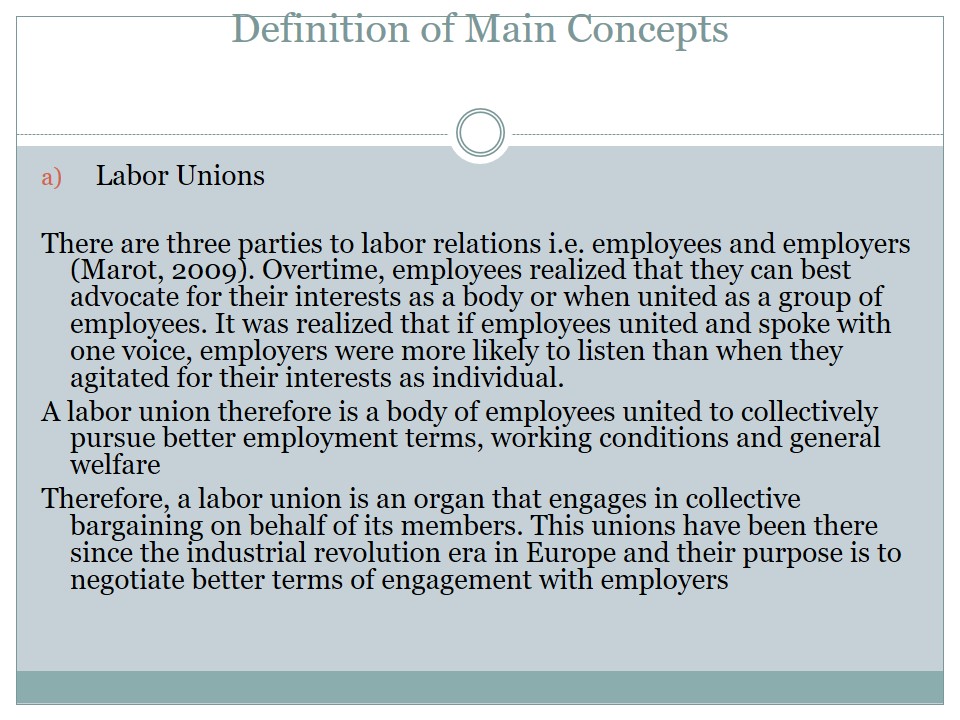
Global Economy
Different national economies merge into what is known as the Global economy.
Over time, there are many radical changes that have happened in the information and communication technologies as well as in the transport sector of economies.
Changes in ICT and Transport has reduced the space between people leading to the global village phenomenon.
Globalization has led to the global economy being more merged and unitive than before. As companies continue to ride on globalization related changes, the jurisdiction of labor unions has to be redefined.

Statement of the Problem
Organizations riding on the globalization wave are different in structure and culture from the traditional organizations.
Modern times have seen the emergency of more multinational corporations and e-based organizations.
The internationalization of operations and existence of e-based organizations tends to render traditional labor unions redundant or ineffective.
The traditional remedies and channels of communication used by labor unions are now challenged by the new organizational characteristics or phenomenon.
In the face of all the challenges based on globalization related characteristics, the question on the mind of trade or labor unionists is how to survive and remain relevant.
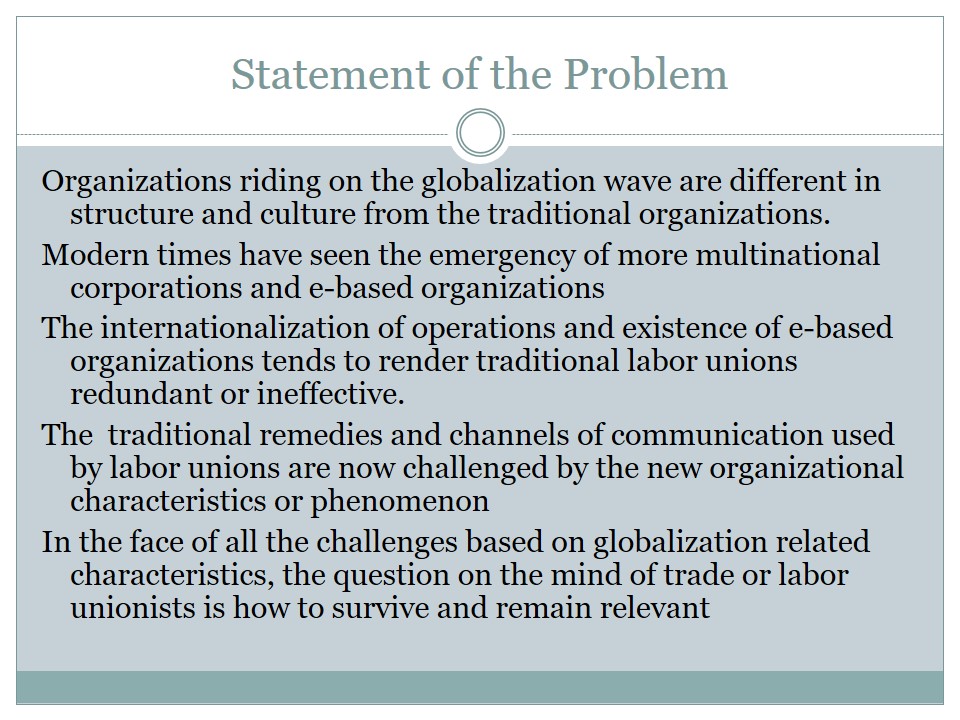
Research Objectives
- General Objective:
- To establish whether labor unions will survive in the global economy.
- Specific Objectives:
- To determine how globalization is affecting labour unions.
- To establish the relevancy of trade unions in the global economy.
- To identify how labour unions are redefining themselves as to suit the demands of the global economy.
- To determine the factors like to lead to demise or survival of the labour unions in the globalizing economy.
- General Research Question:
- Will trade unions survive in today’s global economy?
- Specific Research Questions:
- How is today’s global economy affecting operations of labor unions?
- Are trade unions still relevant as per demands of today’s global economy?
- In what ways are labor unions redefining themselves so as to meet with the demands and challenges or today’s global economy?
- What factors are likely to lead to the demise or survival of labor unions in today’s global economy.
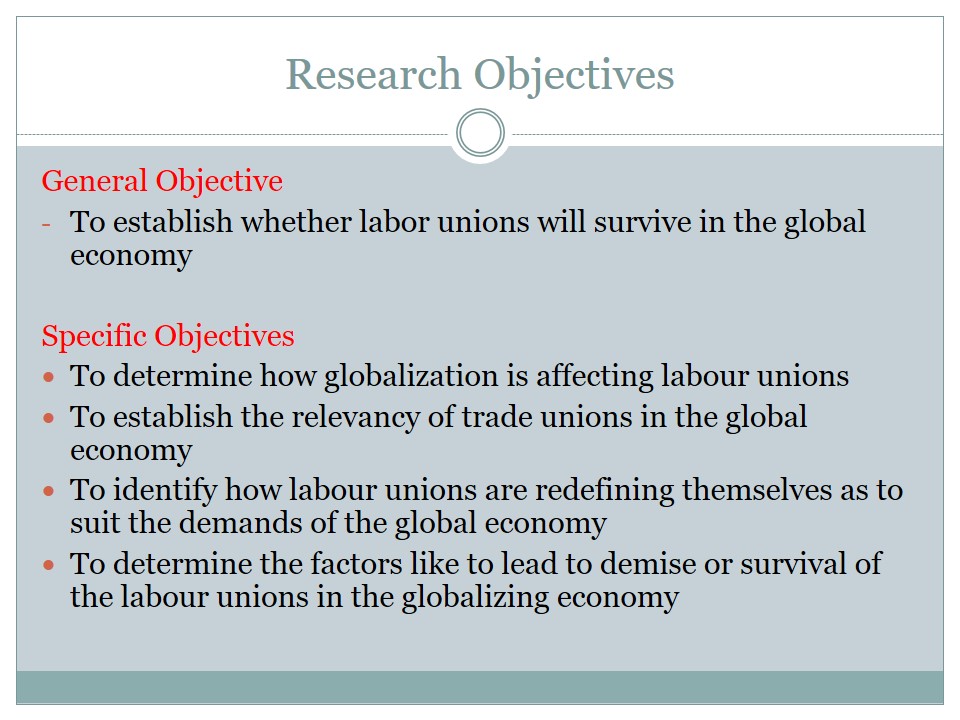
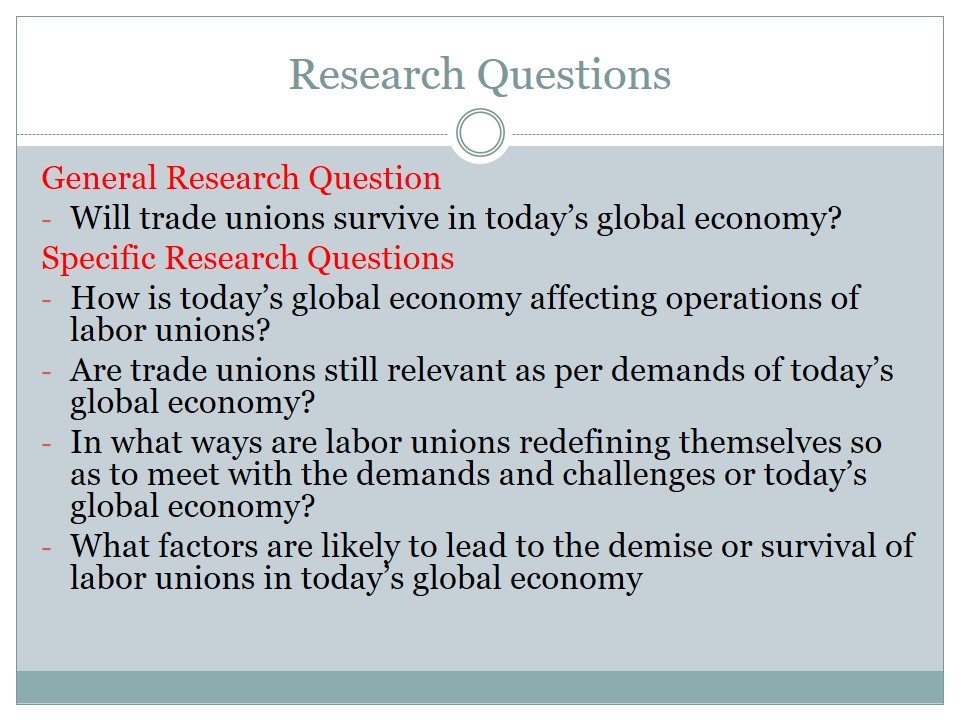
Significance of Study
Labor Unions play a significant role in ensuring equitable or amiable relations between employers and employees.
Without trade unions, industrial disputes are not easily handled. Labor unions make it easy for employers to know who to deal with among employees.
They also help employees to collectively bargain and avoid victimization of individuals.
This research work is beneficial to the following:-
- Labor unions:
- labor unions can use the findings of this study to re-evaluate their operations in a globalizing context.
- Employees:
- Employees will be able to use the findings as guide when it comes to formation of unions or as a tool to identify ways of rejuvenating their labor unions.
- Employers:
- Employers also benefit a lot from the services of labor unions. This research work will help them identify ways of supporting labor organizations such that they survive or remain relevant in the globalizing economy.
- Government agencies:
- Governments are charged with the duty to providing or facilitating the provision of meaningful employment to all citizens. This study is a good basis for identifying challenges facing labor unions and ways of helping this organizations either through legislation or other initiatives.
- Non governmental actors involved in advocating for better work conditions:
- Just like the government agencies, non governmental agencies play a critical role or are major actors in international affairs. This research would help them to streamline their advocacy and response efforts to challenges facing labor unions.
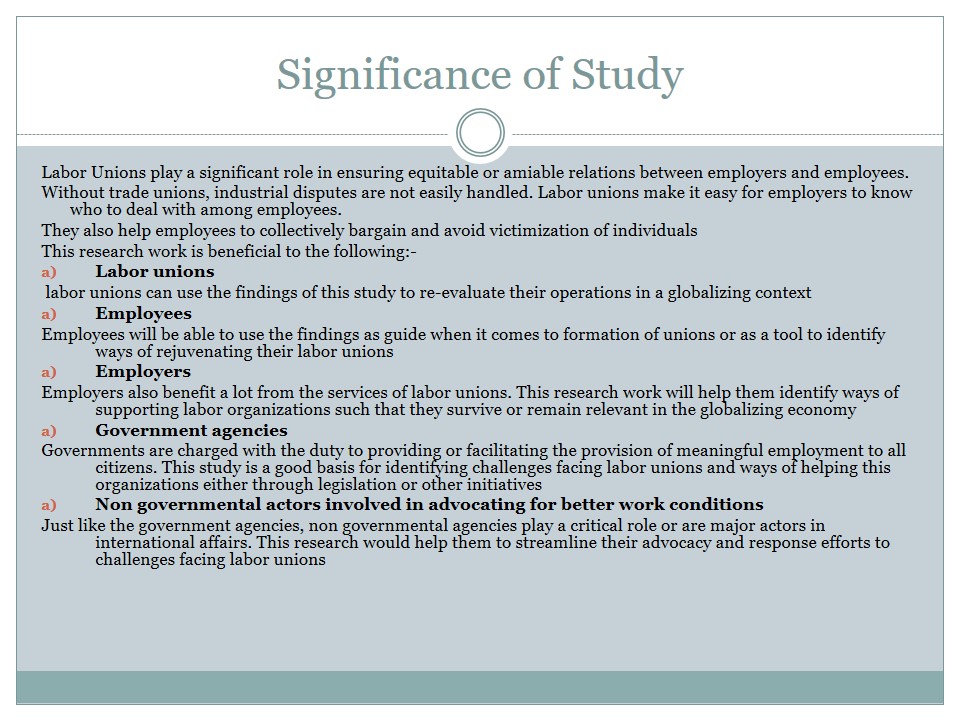
Scope of Study
This study will focus on selected labor unions in the united states.
The labor unions to be studied will be chosen on the basis of different economic sectors and geographical dispersion.
Further, the researcher will rely on reports from the International Labour Organization to augment the findings from selected labour unions in the united States. This will also be done for the purposes of generalization across the global society.
The key focus of the researcher will be on the globalization related challenges facing labor unions. This is does not negate the existence of other challenges. Labour unions have been docked with challenges especially internal wrangles since time immemorial.
Therefore, despite other factors affecting survival of labour unions, the focus will be on global economy related challenges and how labour unions are addressing themselves to them.
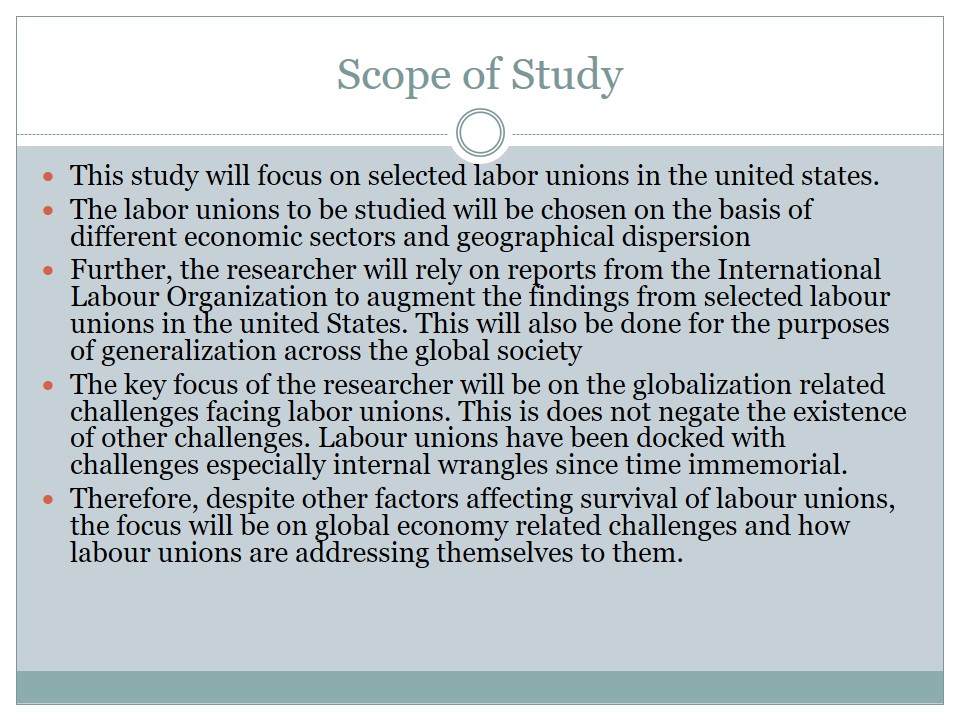
Hypothesis
Despite many challenges facing labor unions due to globalization and its effects on economies, the labor unions will survive and become even more powerful.
This hypothesis is pegged on the fact that labor unions are also adopting a global outlook and as more unity between different labor unions is sought, they are likely to become even more powerful actors not just in labor issues but in the international political economy (Gordon & Turner, 2000)
Secondly, labor unions are valued and cherished by all stakeholders in industrial relations (Guthrie, 2002). Therefore, there is every likelihood that all players will combine to ensure labor unions are redefined.
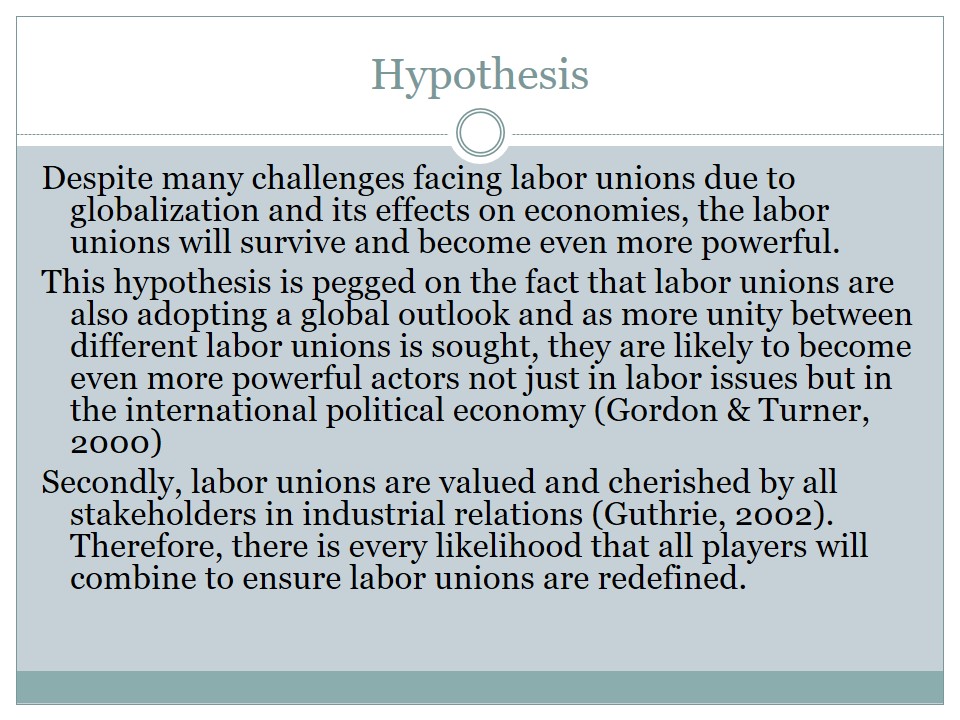
Research Methodology
Research methodology basically refers to the approach the study will take.
This research work will rely heavily on both quantitative and qualitative, primary and secondary data.
Therefore, the research design to be used has to respond to the research peculiarities.
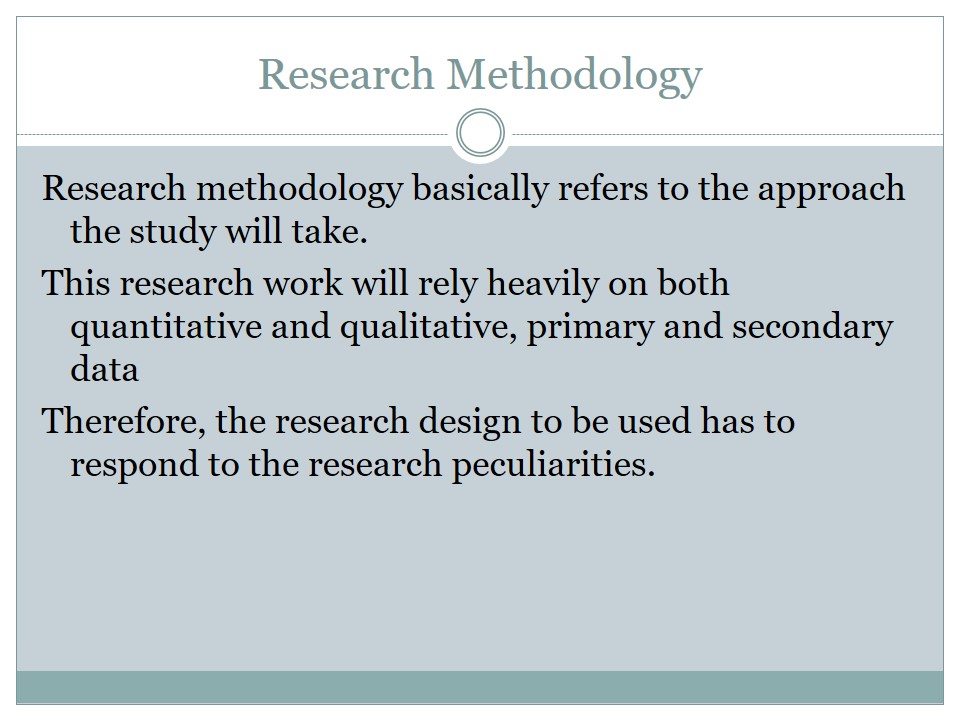
Research Design
Research design determines the essence and flow of a research project. Research design refers to the structure or all the key aspects of a research project (Ackroyd, & Hughes, 1992, p. 9).
The way a research has been designed has a great bearing on research validity and reliability.
This research aim as capturing factors in the global economy that are likely to lead to failure or survival of the labor unions. Therefore, the researcher will have to collect information from selected labor unions, governmental agencies, employer associations and other non-governmental actors like the International labor Organization.
Due to the spread of respondents, the research will have to rely on sampling techniques so as to come up with representative views on whether labor unions will survive in the globalizing economy or not.
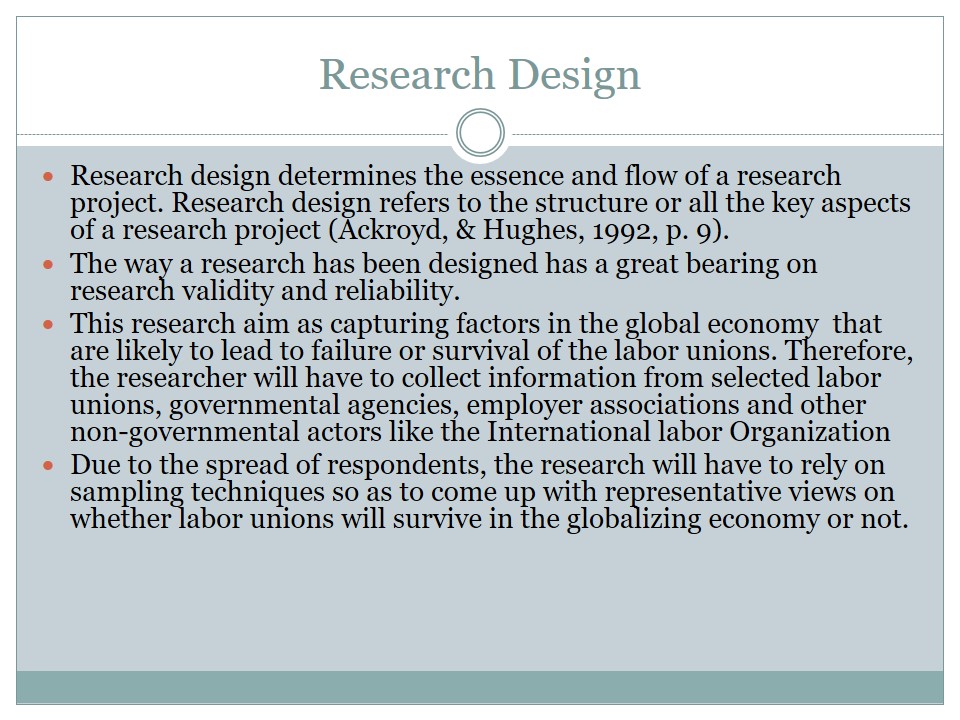
Research Type
Although this research project will rely on both qualitative and quantitative data, it is more qualitative than quantitative. Quantitative research differs in a big way from qualitative research because it uses quantitative data or numerical measures. Qualitative research focuses more on qualities and captures data that is not numerical in nature. The difference in the kind of data captured also leads to differences in the way data is recorded and analyzed. While quantitative research relies more on statistical methods e.g. regression analysis, qualitative research findings are analyzed basing on relation between qualities.
Qualitative researches are descriptive in nature. Much of this study analyses and describes relations between different global economy characteristics and their effects on the labor unions. A research design has to be responsive to the situation or context of the research.
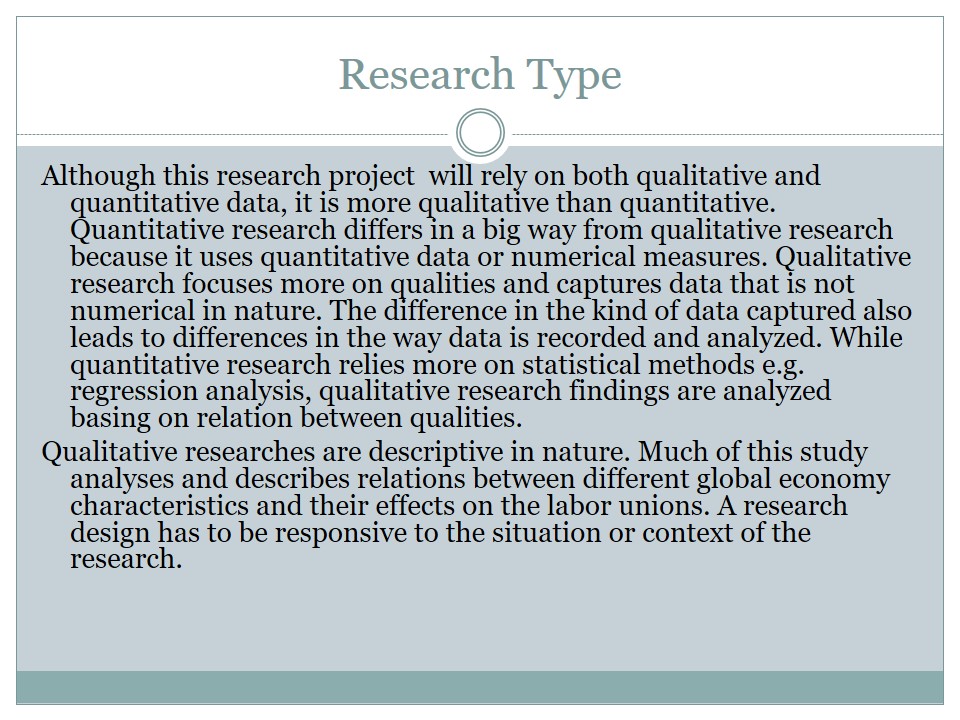
Target Population
This research targets to collect information from:-
- Selected labor unions.
- Selected employer associations.
- Government agencies.
- International labor organization.
- Non-governmental actor dealing with labor issues.

Sampling Techniques
The spread or distribution of respondents necessitates use of both stratified and random sampling techniques.
Stratified sampling method will be used in identifying respondents from every category i.e. labor unions, government agencies, non-governmental actors and employers’ unions. This will be done so as to get a full representation from the available categories of respondents
The research will apply random sampling to draw respondents from each stratum. Random sampling within stratum will be used because it enables the researcher to gather general views across the representation in the stratum.
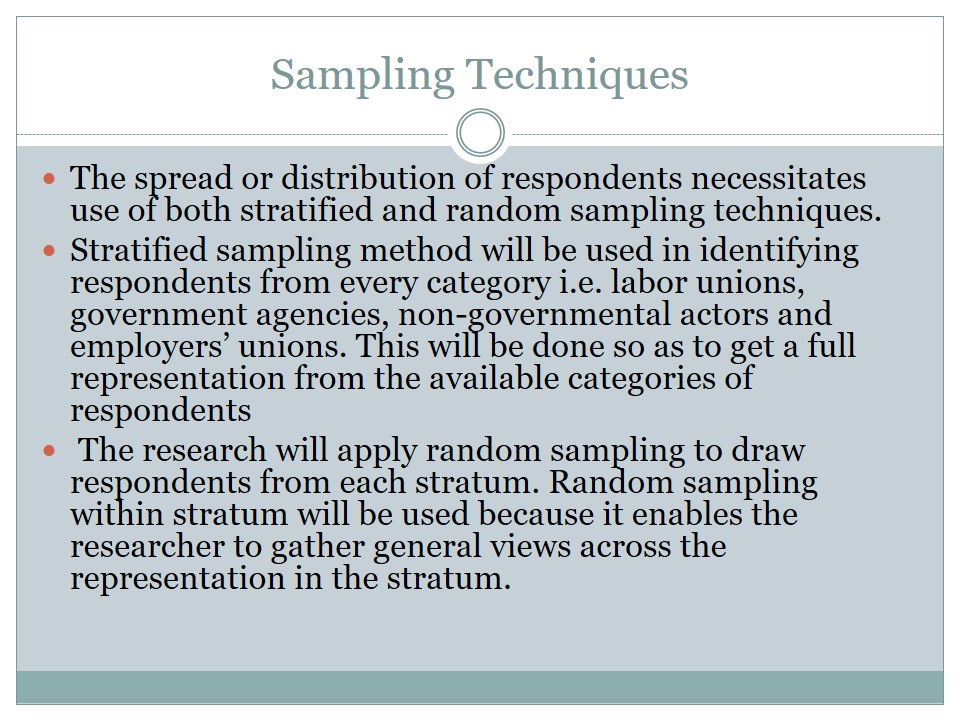
Data Collection
- Both secondary and primary data will be collected.
- To collect primary data, the researcher will employ both the use of different kinds of questionnaires and interviews.
- The questionnaires will be administered both at group and individual level as case may warrant.
- The interviews will be done in person or over the telephone.
- The researcher will rely on emailing questionnaires so as to reach as many labor unions as necessary.
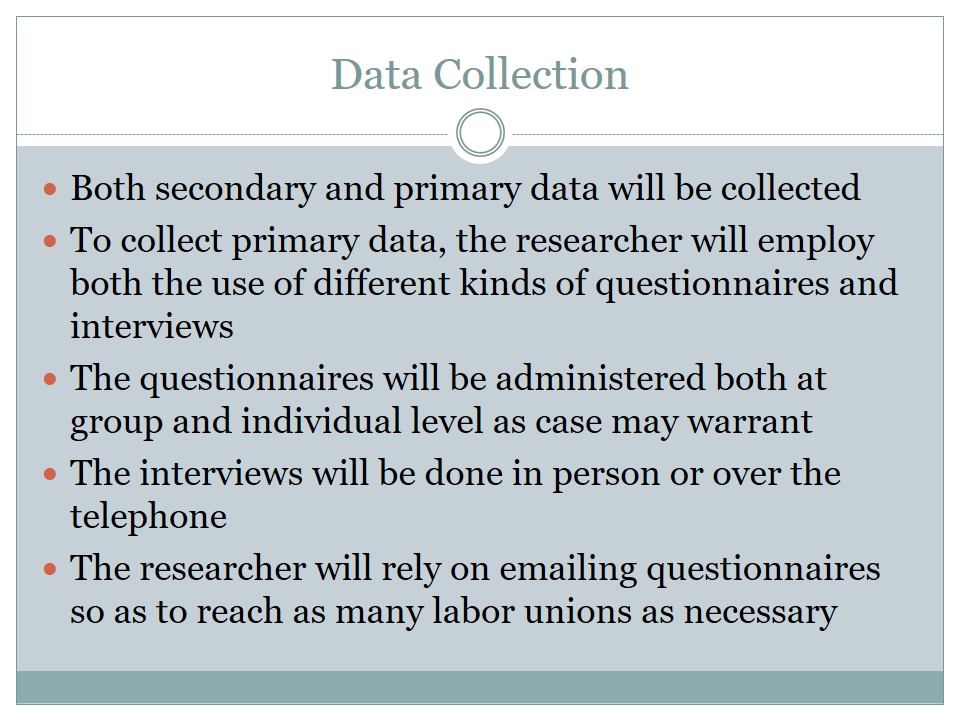
Data Recording, Analysis and Presentation
Data will be recorded through filling in of questionnaires, note taking and tape recording.
Given the research will capture both qualitative and quantitative data, different software and ways of presenting data will be used. For qualitative data, Nvivo software will come in handy in the analysis while quantitative data will be analyzed using SPSS.
Quantitative data is numerical and provides statistical appraisal of a situation. Qualitative research methodology applies more in scenarios where the researcher is not sure of what to expect. In quantitative research, the researcher is clear about what he or she must be measuring so as to institute the measures.
Analysis of qualitative data results in a detailed description or report (Williams, 2000, p. 80). The description captures relationships established based on judgment of individual researcher. Therefore, qualitative data facilitates the establishment of a general description of phenomena. Quantitative analysis on the other hand enables for classifications based on counted features and thus enables construction of models that can be understood in a statistical manner (Crotty, 1998, p. 124).
The analysis will aim at describing phenomenon or issues, identifying trends and seeking explanation for trends through establishing interrelation between facts.
To concretize, summarize and illustrate trends identified from the data, Flow charts, data flow diagrams, graphs and other forms of charts will be employed in data tabulation and presentation.
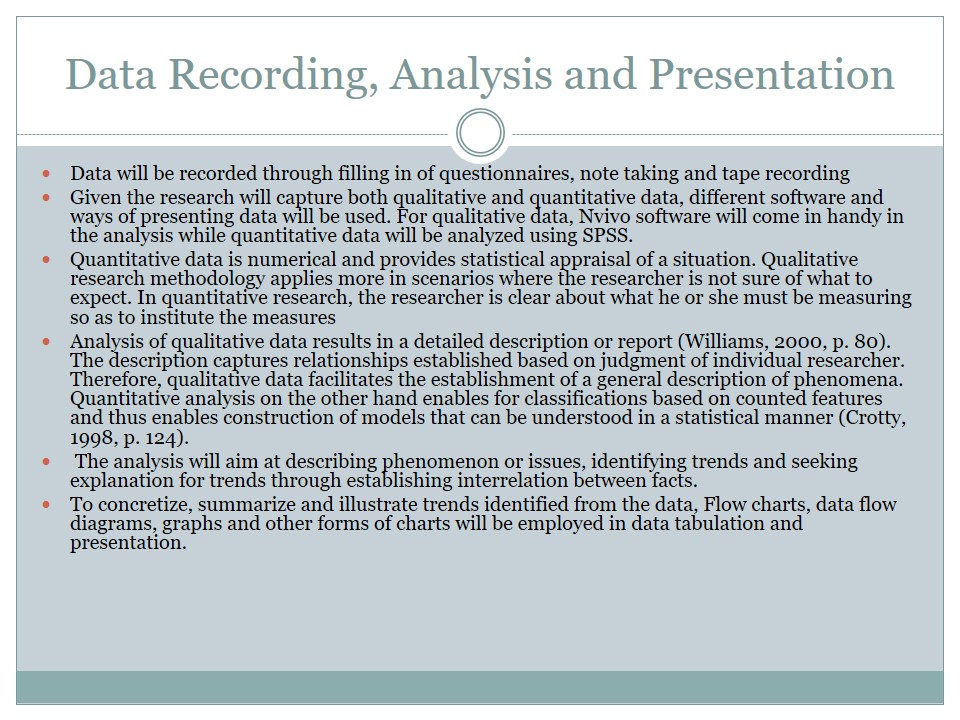
Resource Requirements
The following resources are paramount if this research project is to be completed successfully:
- Time.
- Money.
- Research assistants.
- Introduction letter from school.
- Relevant software.

Time Needs
Doing Literature Review: 1 months:
In the literature review, the research will investigate into operations of a contact centre, establish working relation between contact centre and awarding bodies, investigate documented interrelation between contact centre, awarding body and candidates, discuss customer relationship management and its impact on business, discuss different CRM software available, and review discussed information in light of developments in IT and changing business landscape
Developing research tools as per Research Methodology: 3 weeks:
Having done the literature review, the research methodologies will be the next consideration. The researcher will investigate into Research Methodologies leading to development of a Questionnaire, Designing Research Strategy and Piloting questionnaire, evaluating and finalize on questionnaire then finalizing on sampling methods and criterion
Data Collection 2 Months:
Data collection will involve distribution of questionnaires and scheduling of interviews. Once questionnaires have been filled, the researcher will collect them or prompt their being returned. Interviews will be scheduled some weeks in advance to ensure availability of interviewees.
Analysis of Data: 1.5 months:
Once data has been collected, researcher will embark on analysis. Analysis will be done with close reference to written literature as an evaluation starting point.
Once data has been analyzed and triangulated, a report will be written indicating clearly the findings, conclusions drawn, how the conclusions are reached and the recommendations arising of the same findings.

Literature Review Requirements
A literature review is an important aspect of a research paper. It is from a literature review that one is able to contextualize a study in the context of existing theories or literature. Social researchers are better off when they base their research on common social research theories. These theories basically ground the research work e.g. by defining how social problems arise and possible ways of solving them. Incrementally, a concern for pattern matching as a way of establishing interrelation between phenomena is what guides theorizing and research efforts. Each research project has to be based on a theory and contribute towards a theory. It is only through grounding research in theory that causal relationships can best be understood. In the context of theory, research findings gain a wider perspective. Theory serves two purposes in research design; it guides the implementation of a research design and later can be used as basis for analysis of gathered data. Therefore, theory is good for definition of research process but also in the evaluation of outcomes.
The literature review for this study will look into:-
- What trade unions are.
- Functions of trade unions over time.
- The history of labor unions.
- Milestones or achievements of labor unions.
- Challenges of trade unions across history.
- Globalization.
- Challenges to labor unions from globalization.
- Opportunities for trade unions occasioned by globalization.
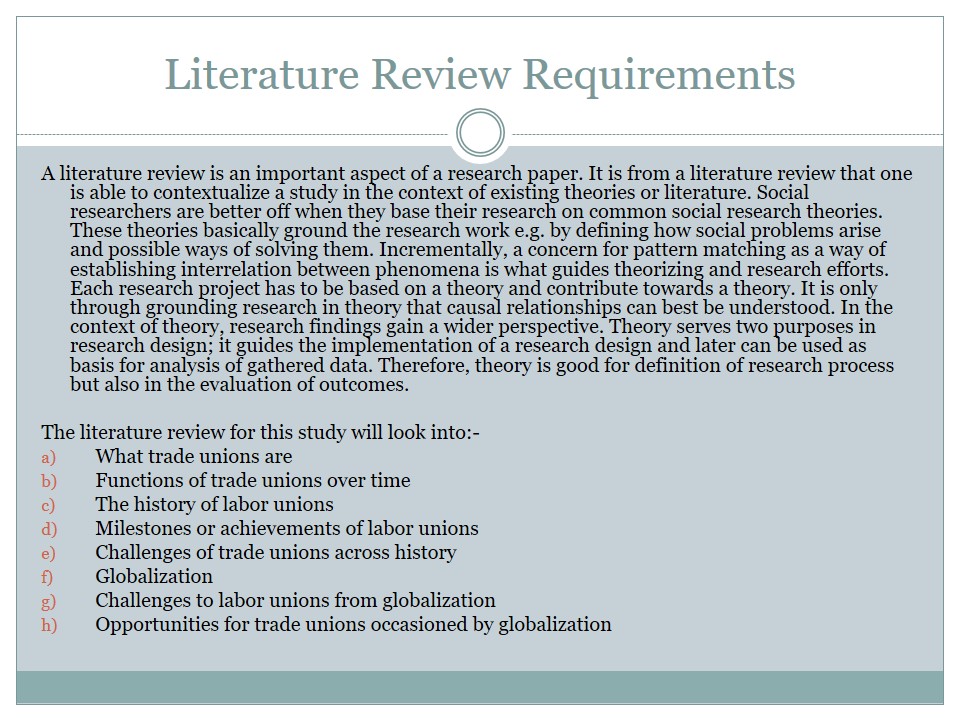
Monetary Requirement/Budget

Conclusion
As indicated, this research work is bound to benefit many people in our economy. Its findings are not only beneficial to the employees and employers, they can also facilitate better engagement of non governmental agencies and government agencies in industrial relation matters.
The research design proposed aims at ensuring research validity and reliability.
Through use of representative samples and targeting a wide variety of respondents, the conclusions to be arrived at will be valid conclusions.
Further, effort will be undertaken to design research tools or data collection tools accurately such that only relevant data is collected.
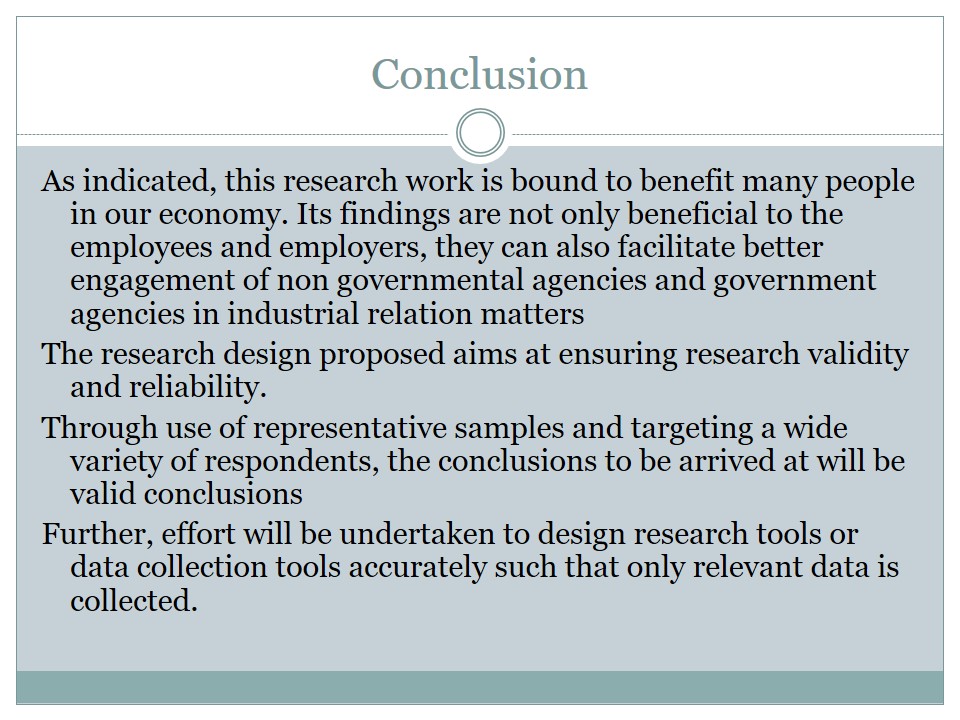
Reference List
Ackroyd, S., & Hughes, D. (1992). Data Collection in Context. London: Longmans.
Bryman, A. (1993). Quantity and Quality in Social Research. London:Unwin & Hyman.
Gordon, M.E. & Turner, L. (2000). Transnational cooperation among labor unions. New York: Cornell University Press.
Guthrie, G.G. (2002). Labor unions: champions of social justice. Washington, DC: Georgetown University.
Marot, H. (2009). American Labor Unions. New York: BiblioBazaar.